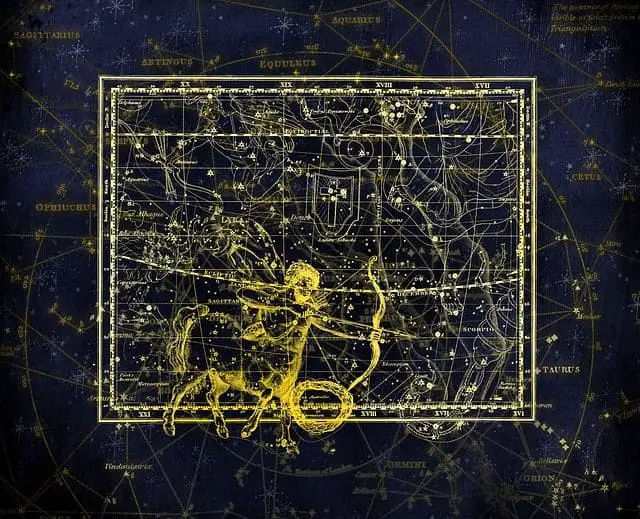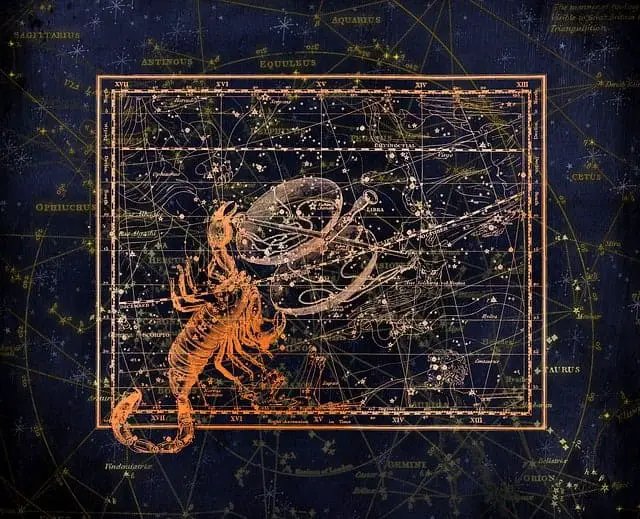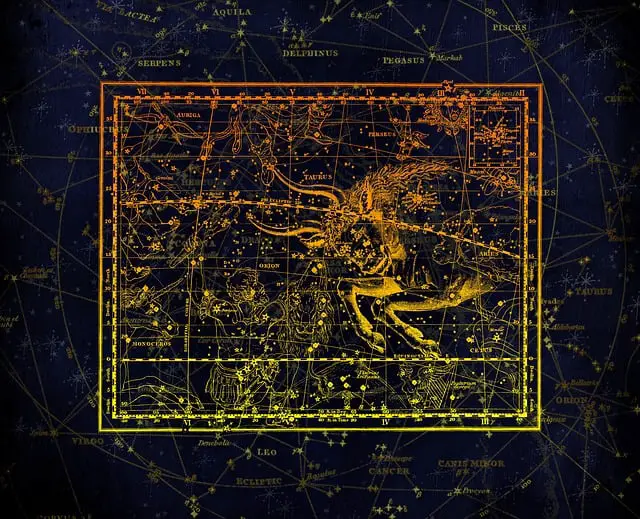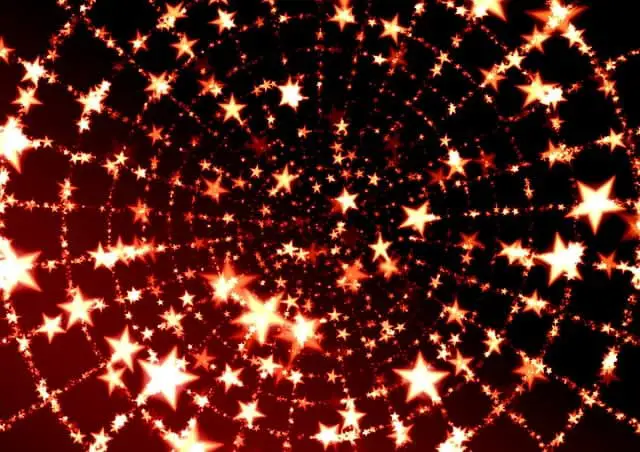Stars have always fascinated us humans. These celestial bodies have guided us since times immemorial – both on land and at sea. Stars give us hope during dark and turbulent times. They are majestic and awe-inspiring making stars symbolism a powerful metaphor in our lives. We also associate stars with success and goals – so we wish someone to “reach for the stars” to help them achieve their highest potential.
In this guide, we will cover the meaning of stars and their symbolism in spirituality, various cultures, and art.

What Do Stars Symbolise?
Across cultures, stars have deep symbolic and metaphorical meanings. Throughout history, these celestial bodies have represented hope, spiritual guidance, and divine presence.
Many people still believe the stars to be their guides in their personal and professional lives. The stars offer direction and hope. Since they shine at night, they also represent positivity and hope in dark, turbulent times.
Metaphorically, stars represent dreams, hope, optimism, and guidance. They also represent uniqueness. Stars also mean someone at the top of their game. We call celebrities stars because they shine and sparkle on the red carpet. Stars also mean someone who is number one in their field. Thus, they symbolize wealth, success, achievement, fame, and the top of the summit. A person is called a star when he/she is a great achiever in their field.
Stars are also a symbol of beauty and wonder. They inspire poets, artists, and writers. In literature, stars symbolize romance, love, and deep connections.
In short: stars hold great significance in art, music, literature, and spirituality.
Is a Star Symbol Good?
Yes, stars are a wonderful symbol. Stars are like little beacons of hope and guidance. They light up the dark sky, showing direction to travelers and sailors for ages. The stars can represent dreams, goals, and ambitions. When you see a star, it is a reminder to aim high and reach for your dreams, no matter how far they seem.
Stars also mean different things in different cultures. They’re like a universal language – in Greek stories, they’re heroes in the sky, while for some Native American tribes, they’re ancestors watching over us.
Stars remind us of the beauty of the night sky. They are humanity’s connection to something bigger, something divine. Stars are a symbol of wonder and inspiration. They are a reminder that in the darkest times, there’s always some light shining somewhere.

Stars Symbolism of Good Luck? What Message Do Stars Convey?
Stars are a fantastic symbol of hope, good luck, dreams, and guidance. They help connect us to the mysteries of the universe. They are little reminders to keep looking up and moving forward. Here are some messages stars give us:
- If you see a star, you can expect magic!
- If you have recently prayed for something, the appearance of a star means your wishes will be fulfilled.
- The dark part of life is over; the star is a beacon of hope.
- Celebrate your uniqueness
- Your angels are watching over you
- Open your eyes to your inner voice or intuition.
- Prepare to recognize opportunities and take action.
- Someone is thinking of you.
- Be encouraged that good things are coming your way.
- You are not alone. Good friends are nearby.
- Clear your mind and let go. Everything will be alright.
What is The Stars Symbolism in Love?
In love and romance, stars symbolize a deep connection. They represent the beauty of relationships and the everlasting aspect of love. These celestial bodies also symbolize eternity. Their bright light evokes feelings of hope and optimism. They represent the uniqueness of love.
Couples often use stars as a symbol of their love. Many romantic poets use stars as metaphors to describe their love for their beloved. Here, stars stand for constancy and purity. Long-distance lovers use stars metaphorically to find deep connection with their beloved across the seven seas. For romantics, stars are beacons or guiding lights. They offer hope and direction and they symbolize purity in their relationship.
Stars also represent wishes and dreams in relationships. People wish ‘the stars bring good fortune’ to their loved ones. Stars also stand for the dreams people share with the ones they love. These twinkling entities represent their hopes and dreams for a bright future.
Thus, stars represent a deep connection to the essence of love, romance, and relationships. They are symbols of hope, guidance, and universal blessings. They also represent beauty, wonder, and eternity.
Stars Symbolism in Art?
Stars are an ancient symbol and they have deep significance in art. Most artists used stars as symbols of hope, guidance, love, deep connection, eternity, good fortune, and divine power. Here are some common representations of stars in different colours:
- Silver stars – a silver star represents feminine power and womanhood. The Silver Star medal is also given for valour so it represents strength and courage.
- Gold stars – these represent achievement, success, growth, rejuvenation, and balance. In schools, gold stars help encourage students as they represent a job well done.
- Red stars – a red star stands for politics, strength, passion, and bravery.
- White stars – white-coloured stars represent purity, wisdom, heavenly entity, divinity, innocence, peace, etc.
- Green stars – green star represents wealth, nature, healing, ecological balance, rejuvenation, and growth.
- Blue stars – blue stars are a symbol of peace, loyalty, serenity, quietness, and protection.
- Yellow stars – these are a symbol of positivity and cheer. They represent joy, vitality, and optimism.
- Black stars – a black star represents mystery, elegance, and promise.

What Do Stars Represent Biblically?
Stars hold great significance in Christianity. God created stars on the fourth day of creation.
He had promised Abraham’s descendants numerous stars in the sky, which means stars represent blessings and abundance.
The 3 magi or wise men, followed the Star of Bethlehem to find Baby Jesus. In some Bible passages, stars are used metaphorically to represent individuals or leaders, signifying their influence or brilliance. The stars also represent the 12 tribes of Israel. In Rev. 9:1 the falling star represents the defeated king of Assyria. The seven stars also represent the dead people granted immortality. In the New Testament, the seven stars denote a divine messenger or angel.
The Christian 8-pointed star symbolizes rebirth and resurrection. The six-pointed star is one of the oldest Christian symbols, known as the Star of David.
Stars Symbolism in Mythology?
Across cultures, stars have held deep symbolic meaning in different mythologies. They often represent gods, angels, spirits, and legendary figures.
Star Symbolism in Greek Mythology
The Greeks believed that stars represented bright spirits that once roamed the earth. For them, shooting stars represented falling souls that were ascending. The Greeks also believed that the gods placed heroes and notable figures in the night sky as constellations, immortalizing their deeds.
Zeus – the King of Gods- is believed to have sent the Great Bear to the stars. ASTRAIOS (Astraeus) is the Greek god of stars.
The Titan Atlas was forced to hold up the sky for eternity. Consequently, he was unable to protect his seven daughters from Orion the Hunter. Atlas begged Zeus to help, so Zeus converted the sisters into stars. These seven stars – The Pleiades – formed a constellation.

Stars Symbolism in Hindu Mythology
Hindus call the star constellations nakshatras. There are 27 nakshatras in all and they are 300-400 light years away from the earth.
Hindu astrologers believe that stars play a huge role in the luck and good fortune of every individual. Thus, stars are seen as celestial markers to guide individuals in their journeys. They are integral to determining auspicious times for ceremonies. Even today, couples’ families consult the bride and groom’s star charts, or kundalis, before their marriage to ensure compatibility and a good life. Astrologers also recommend rituals and ceremonies to overcome the negative influences of stars and planets.
In Hinduism, the six-pointed star symbol called shatkona or hexagon is a powerful yantra that represents the masculine and feminine forms, Mother Nature, and the supreme being. Likewise, the 8-pointed star is the symbol of Goddess Lakshmi, who represents wealth, good fortune, knowledge, and virtue.
Stars Symbolism in Chinese Mythology
The Chinese symbol for star represents light in the night sky but it also means to spread or disseminate. Stars also represent gods, cosmic order, and harmony of the universe in Chinese folklore. As in Hindu mythology, Chinese astrology is also based on the positions of the stars and planets. Stars also symbolize luck, wealth, and success.
Stars Symbolism in Celtic Mythology
The Celts believe that stars represent ancient knowledge and sacred wisdom. Stars were also believed to be linked to enchantment, magic, and religion. There are various Celtic symbols and the Celtic star is one of the most important ones. It stands for being, eternity, and spirit life.
The five-point Celtic star stands for the Goddess of the Underworld but also represents the balance between the 5 elements – air, water, earth, fire, and spirit. The ancient Celts used stars for navigation and watched for the appearance of the star cluster Pleiades to recognize the start of winter.

Stars Symbolism in Norse Mythology
In Norse mythology, stars were believed to be sparks from the realm of Muspelheim, created by the fire giant Surt. The Vikings navigated the seas using stars like Polaris, which they called the ‘Pole Star’ or Norse Star.
The stars were also seen as guiding lights, essential for navigation and exploration. They also represented gods and goddesses. A star called Aurvandils-tá (Aurvandill’s toe) was formed when Thor tossed the Old Norse Aurvandils’s frozen toe in the river.
Stars Symbolism in Native American Mythology
Native Americans have many stories about stars and constellations. Most believed the stars to be the spirits of their ancestors. Different tribes also had different beliefs about the different constellations.
For example, the Yakima Tribe thought of the Cassiopeia constellation as dried and stretched elk skin. The Cherokees believed the Canis Major to be the two dogs guarding the path to the land of souls. The Lakota Sioux believed that the spirits of the dead resided in the stars.
Key Takeaways – Stars Symbolism and Meaning
For millions of years, stars have guided humans across land and sea. It is no wonder that ancient civilizations viewed stars as angels, gods, or divine messengers. They also considered certain stars, like the North Star, as symbols of hope, eternity, peace, freedom, success, and the need to start again.
In modern times, stars are symbols of achievement and goals. We always tell our loved ones to aim for the stars. These bright, shiny celestial bodies represent the future and destiny.
The five-pointed star represents the five elements – earth, water, spirit, fire, and air. The 5-pointed star encircled is a symbol of protection.
Stars are also viewed as divine beings or gods across various cultures. Therefore, the study of astrology is often viewed as the study of gods. The stars send us positive messages that all will be well. All you need is to let go, trust the universe, and let the stars guide you!

Star Symbolism FAQ’s
1. What is the symbolic significance of stars across different cultures?
- Stars hold diverse meanings in various cultures, often representing guidance, celestial forces, and spiritual connection.
2. Why are stars commonly associated with guidance and navigation?
- Throughout history, stars have been vital for navigation, guiding sailors and travelers. Symbolically, they represent guidance, hope, and finding one’s path.
3. In mythology, what do stars often symbolize?
- Stars frequently symbolize gods, heroes, or divine beings in mythology, representing cosmic power, enlightenment, and eternal truths.
4. How are stars represented in literature and poetry?
- In literature and poetry, stars are commonly used as metaphors for inspiration, aspirations, and the pursuit of dreams. They evoke a sense of beauty and the infinite.
5. What is the significance of a lone star as a symbol?
- A lone star often symbolizes uniqueness, individuality, and standing out. In flags, it can represent a single state or a solitary guiding principle.
6. How do stars symbolize hope and positivity?
- Stars, with their brightness in the night sky, are often seen as symbols of hope and positivity, representing the idea that even in darkness, there is light.
7. Do stars hold religious significance?
- Yes, stars hold religious significance in many faiths. They are seen as divine creations, embodying the glory of the Creator and serving as a connection between the earthly and the celestial.
8. What does a shooting star symbolize in folklore?
- In folklore, a shooting star is often considered a symbol of good luck or the fulfillment of wishes. Many cultures believe that making a wish upon a shooting star will bring it to fruition.
9. How do stars symbolize eternity and immortality?
- Stars, being seemingly eternal and unchanging, symbolize eternity and the immortal nature of the cosmos. They represent continuity, timeless wisdom, and the enduring legacy of the universe.









